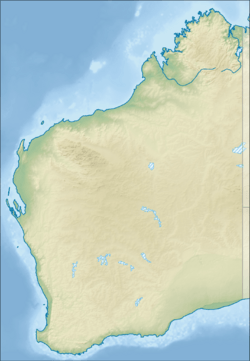Lake Wooleen facts for kids
Quick facts for kids Lake Wooleen |
|
|---|---|
| Location | Western Australia |
| Coordinates | 27°4′24″S 116°11′4″E / 27.07333°S 116.18444°E |
| Type | Intermittent freshwater lake |
| Basin countries | Australia |
| Max. length | 27 km (17 mi) |
| Max. width | 3 km (1.9 mi) |
| Surface area | 5,500 hectares (13,591 acres) |
Lake Wooleen is a special kind of lake in Western Australia. It is known as an "intermittent freshwater lake system." This means it does not always have water. It is also listed as an important wetland by a group called DIWA.
You can find Lake Wooleen in the Mid West part of Western Australia. It sits on a large property called Wooleen Station. The lake is about 148 kilometres (92 mi) north of Yalgoo. It is also about 176 kilometres (109 mi) west of Cue.
Contents
About Lake Wooleen
Lake Wooleen covers a huge area, about 5,500-hectare (14,000-acre). It is located on the Yilgarn Craton, which is a very old part of the Earth's crust. The lake sits in the flood plain of the Roderick River. This means it is in a flat area next to the river that can get covered by water.
How the Lake is Formed
Lake Wooleen is a flood plain lake. It is made up of two main parts called claypans. These claypans are like large, flat areas of clay that can hold water. A narrow "neck" of land connects these two claypans. There are also marshes around the lake. The land around the lake is gently rolling, with some hills and rocky areas.
Water Levels and Flow
The lake does not always have water. It usually gets some water about once every four years. It fills up completely with water about once every ten years. Big floods, where the lake overflows, happen about once every thirty years.
The lake's position on a fault line is important. When the lake gets too full, its water can flow into the Murchison River. But sometimes, when the Murchison River is flooding, its water can flow into Lake Wooleen instead!
When the Lake Fills Up
The lake usually fills up because of heavy rain. This rain often comes from tropical weather systems. These big rain events happen in autumn and summer. When the lake is full, the water can be several metres deep. It can take as long as ten months for the lake to dry out again.
When the lake is full, its water is fresh. But as the lake starts to dry out, the water becomes more salty. This change happens because the water evaporates, leaving the salt behind.
Plants Around the Lake
The plants growing in the lakebed and claypans are mostly shrubland. You can find plants like samphire and lignum here. These plants are tough and can handle the changing water levels. Around the edges of the lake, there are low, open woodlands of Eucalyptus camaldulensis trees. The areas further away from the lake have taller, open shrubland.


